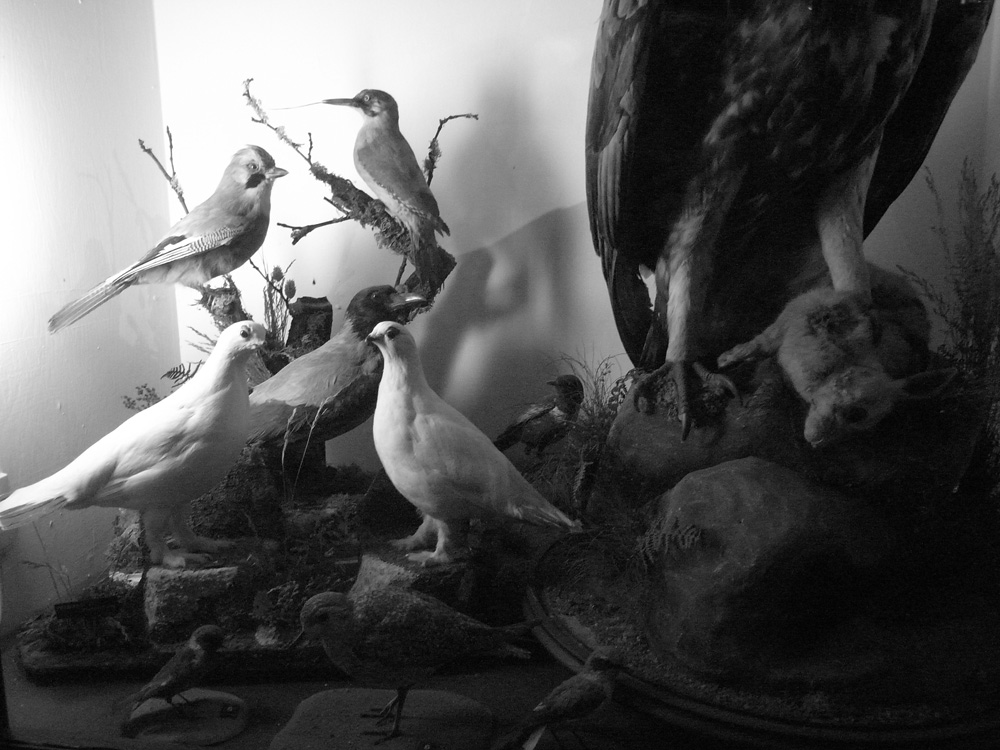Between August 2010 and April 2011 we were invited by Creativity Works and the Rossendale Museum to join the ‘New light on old bones‘ collaborative research team, looking at how the perception and presentation of natural history collections as social history is a legitimate and potentially rewarding curatorial approach. We were asked to explore ways in which this research might lead to new creative strategies for museum interpretation and visitor interaction. How can taking a closer look at the context of a museum’s collection (why museum exhibits were collected, why they were displayed, and why are they still displayed), help society engage with issues such as mortality and wellbeing, or connect people to an understanding, sensitivity and appreciation for both their natural and built environments?
Over a period of six weeks we experimented with a variety of inter-disciplinary and site-specific approaches, drawing on interviews with local residents and background research, to develop a series of projects and activities that aimed to do the following:
- Involve or link the community with the museum and the NLOB research process.
- Develop tools for visitor interaction and museum interpretation that explore the notion of natural history as social history.
- Generate dialogue and compile contemporary research regarding the social context of museum exhibits, the act of collecting or displaying artefacts, and our shifting relationship towards nature and the environment.
- Explore creative approaches to PR and marketing, shaping the way that the museum and the collection are perceived from the outside, to redefine the expectations and museum experience of future visitors.
- Make the process relevant and accessible to the local community, museum staff, and museum visitors.
- Generate a new contemporary chapter of social history relating to the natural history exhibits on display, or in storage, at the Rossendale Museum.
Selected activities:
New light on old bones (quite literally)
The natural history collection at the museum was x-rayed, to create a series of provocative and beautiful images that touch on the afterlives and mortality of the animals on display, while revealing taxidermy practices and the human intervention that was required to construct each exhibit. A selection of images have been physically incorporated into the taxidermy room at the museum, while the remainder are offered to visitors in the form of an exhibition catalogue and presented as an online gallery. More >>>
Each month a collage of texts and images were selected by a group of local enthusiasts or young people in Rossendale that in some way reflect their relationship to nature. This material was compiled to create ‘a newspaper of general interest’, that was used at Tony’s Fresh Fishmongers in Rawtenstall to wrap up the fish & chips, playfully connecting the museum and the NLOB research with the local community. More >>>
The Rossendale medicinal herb garden
The flowerbeds next to the museum were replanted to include a collection of medicinal indigenous herbs that are referenced within the museum’s natural and social history archives. Information packs and DIY teabag kits were created, with which visitors could fill a teabag with herbs from the garden, interactive souvenirs that re-established the historical link between the museum and the surrounding park. More >>>
Suggestions for future activities at the Rossendale Museum:
Dioramas of Rawtenstall
A pop-up photography project exploring the use of dioramas, re-contextualising natural history exhibits within a contemporary community setting, to explore the relationship between the collection and the locality. Dioramas of Rawtenstall could be conducted as a series of workshops, or incorporated into the museum shop, and/or visitor experience.
The museum shop
The development of a long-term strategy that would reconsider the functionality of the museum shop, for a sustainable conceptual approach that involves the local community, and incorporates themes such as trophies, souvenirs and mascots that resonate with both the way we might interpret the natural history collection at the museum and the notion of a museum shop. How could this exchange/shop activity be reciprocal? Can the museum also collect a form of souvenir from its visitors?
Celebrating/Mourning the afterlives
A series of obituaries or birthday announcements are made in the local newspaper relating to the taxidermy exhibits at the museum. An unconventional form of local marketing that explores the afterlives of the animals on display, and questions existing attitudes towards the taxidermy collection. These notices could potentially lead to celebratory or commemorative events at the museum.



